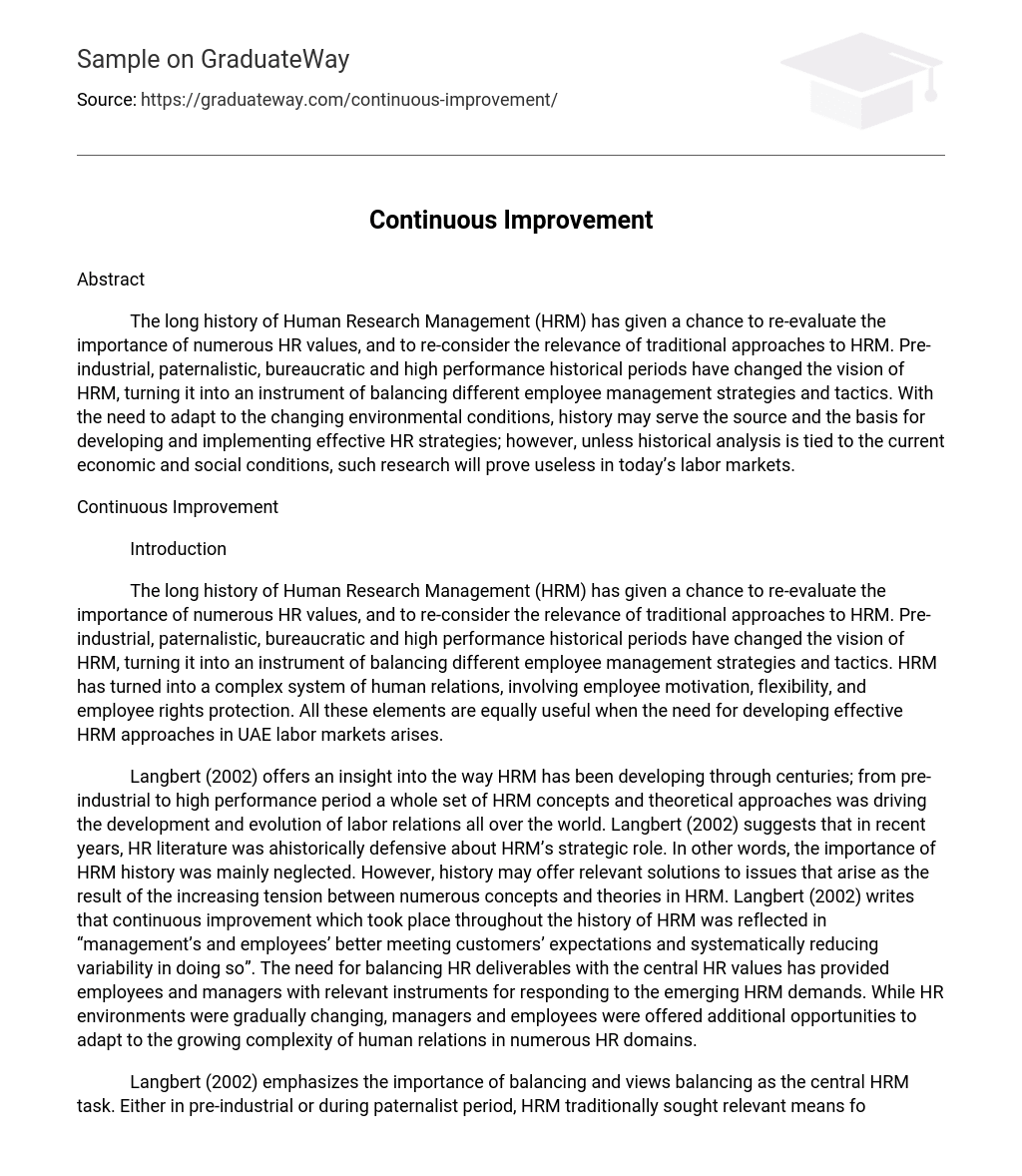Abstract
The long history of Human Research Management (HRM) has given a chance to re-evaluate the importance of numerous HR values, and to re-consider the relevance of traditional approaches to HRM. Pre-industrial, paternalistic, bureaucratic and high performance historical periods have changed the vision of HRM, turning it into an instrument of balancing different employee management strategies and tactics. With the need to adapt to the changing environmental conditions, history may serve the source and the basis for developing and implementing effective HR strategies; however, unless historical analysis is tied to the current economic and social conditions, such research will prove useless in today’s labor markets.
Continuous Improvement
Introduction
The long history of Human Research Management (HRM) has given a chance to re-evaluate the importance of numerous HR values, and to re-consider the relevance of traditional approaches to HRM. Pre-industrial, paternalistic, bureaucratic and high performance historical periods have changed the vision of HRM, turning it into an instrument of balancing different employee management strategies and tactics. HRM has turned into a complex system of human relations, involving employee motivation, flexibility, and employee rights protection. All these elements are equally useful when the need for developing effective HRM approaches in UAE labor markets arises.
Langbert (2002) offers an insight into the way HRM has been developing through centuries; from pre-industrial to high performance period a whole set of HRM concepts and theoretical approaches was driving the development and evolution of labor relations all over the world. Langbert (2002) suggests that in recent years, HR literature was ahistorically defensive about HRM’s strategic role. In other words, the importance of HRM history was mainly neglected. However, history may offer relevant solutions to issues that arise as the result of the increasing tension between numerous concepts and theories in HRM. Langbert (2002) writes that continuous improvement which took place throughout the history of HRM was reflected in “management’s and employees’ better meeting customers’ expectations and systematically reducing variability in doing so”. The need for balancing HR deliverables with the central HR values has provided employees and managers with relevant instruments for responding to the emerging HRM demands. While HR environments were gradually changing, managers and employees were offered additional opportunities to adapt to the growing complexity of human relations in numerous HR domains.
Langbert (2002) emphasizes the importance of balancing and views balancing as the central HRM task. Either in pre-industrial or during paternalist period, HRM traditionally sought relevant means for balancing flexibility with employee rights protection, unionization, and employee motivation. The four different stages of HRM development have proved balancing to be a difficult task. During pre-industrial times, employees were relatively well protected from being fired without a due cause, but lacked motivation and were pressured by state-enforced powers. The paternalist period was marked with the expansion of industrialization and markets; the revolutionary employment-at-will doctrine substantially increased productivity and flexibility of labor markets, but employee equity and alignment were put under risk. Unionization and protective legislation were characteristic of bureaucratic period, promoting equity and alignment but depriving HRM professionals of flexibility in management. Although the current high performance period is characterized by the growing loyalty to free market ideology, it is inevitably associated with equity losses.
I agree to Langbert’s (2002) idea that HRM seeks balancing flexibility with equity, alignment, and employee motivation. I am confident that the central HRM task is to find the most appropriate combination between these concepts; it is essential that this combination is universally accepted and used in different HRM environments. However, I think that under the growing financial pressures professionals will fail to adopt relevant HRM mechanisms, and will further increase the gap between median income and real compensations. In the current financial crisis, equity seems to be losing its relevance, and HRM managers face the need to develop and implement strategically new approaches to recruiting, selecting, and training employees.
Langbert (2002) provides HRM professionals with a chance to look deeper into what constitutes the basis of HRM balancing strategies, and how these strategies were changing in the course of HRM continuous improvement. However, this information will hardly be useful to those who seek innovative approaches to HRM: historical analyses should be closely tied to current labor market realities. Langbert’s (2002) historical analysis may seem irrelevant while financial and labor markets are becoming increasingly complicated. Langbert (2002) seems to have utilized a single-sided approach to evaluating the most important HRM lessons: these lessons should be reconsidered through the prism of the current financial crisis, to shed the light onto the way HR managers can deal with employee layoffs, the outflow of quality workforce, and the decreasing labor force productivity. In UAE, historical HRM research can reveal the hidden facets of HR strategies, when the need for balancing flexibility of labor markets with employee rights protection arises. History is the key to understanding and evaluating previous HR experiences, which may help avoid repetitive mistakes, and may redirect HR efforts in a way to support the development and implementation of balanced approaches in UAE labor relations. Historical experiences should be re-considered through the prism of new and always changing economic conditions; otherwise, professionals may fail to apply historical concepts to everyday issues and conflicts in HRM.
Conclusion
The results of Langbert’s (2002) historical analysis can be used as an effective instrument for revealing the hidden opportunities in HRM. History is the key to understanding the way HRM works in different economic and social conditions, and the way numerous factors including industrialization, unionization, and employment-at-will impact the quality of employer-employee relationships. With the need to adapt to the changing environmental conditions, history may serve the source and the basis for developing and implementing effective HR strategies; however, unless historical analysis is tied to the current economic and social conditions, such research will prove useless in today’s labor markets.
References
Langbert, M. (2002). Continuous improvement in the history of human resource
management. Management Decision, 40 (10): 932-937.





